Philippines and Australia: A Legal Perspective on Education Systems
VerifiedAdded on 2023/06/11
|8
|1496
|75
Report
AI Summary
This report provides a comparative analysis of the education systems in the Philippines and Australia, focusing on their legal frameworks. It examines the educational laws in both countries, highlighting the key differences and similarities in primary, secondary, vocational, and tertiary education. The analysis identifies a gap in the Philippine education system related to quality control and consistent standards, drawing from Australia's established regulatory bodies like TEQSA and ASQA. A recommendation is made for the Philippines to implement an 'Education Quality and Standards Act' to address this gap by maintaining updated curricula, ensuring qualified educators, establishing educational standards, and providing necessary technology and facilities. The report concludes that focusing on quality and monitoring is crucial for the Philippines to improve its education system and meet global standards. Desklib provides access to similar solved assignments and study tools for students.
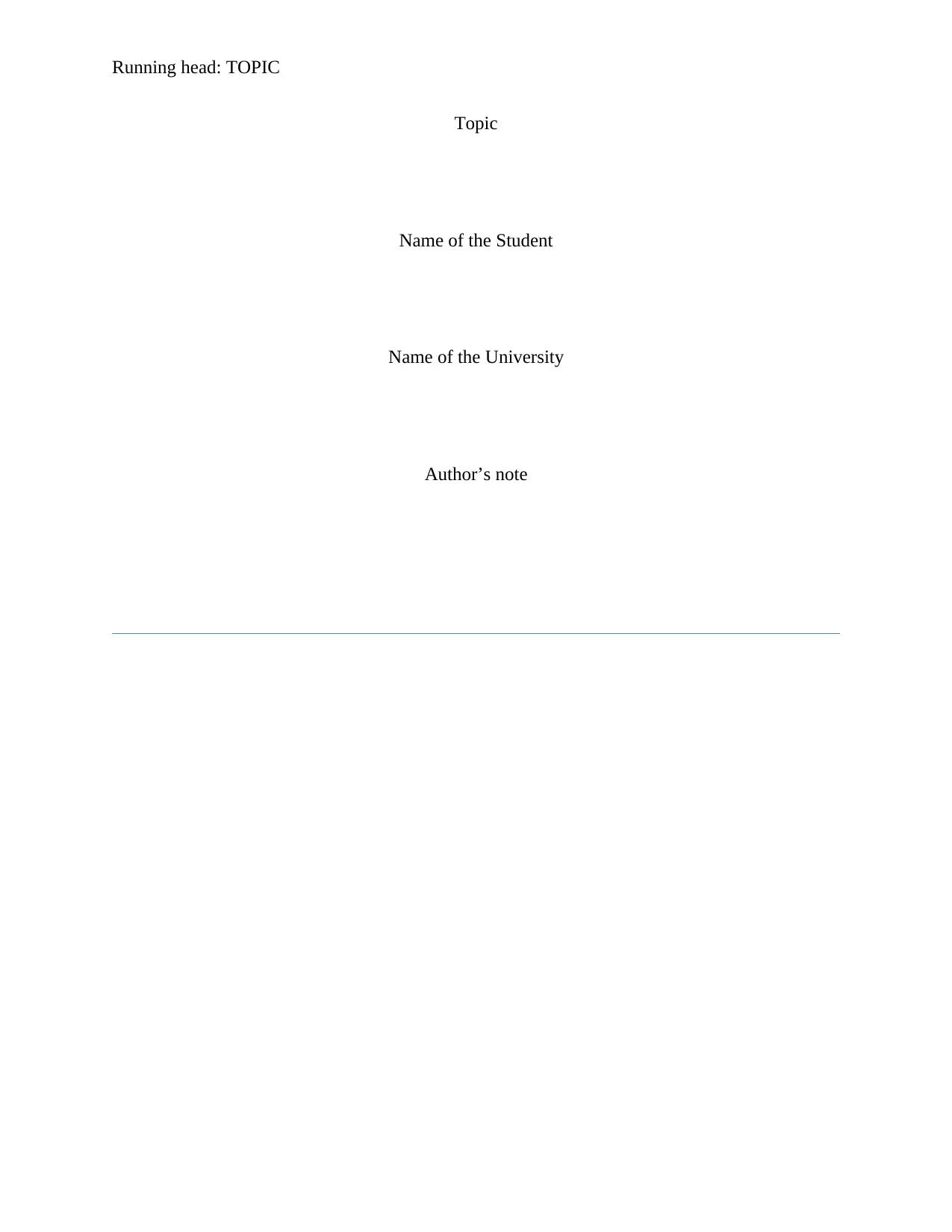
Running head: TOPIC
Topic
Name of the Student
Name of the University
Author’s note
Topic
Name of the Student
Name of the University
Author’s note
Paraphrase This Document
Need a fresh take? Get an instant paraphrase of this document with our AI Paraphraser
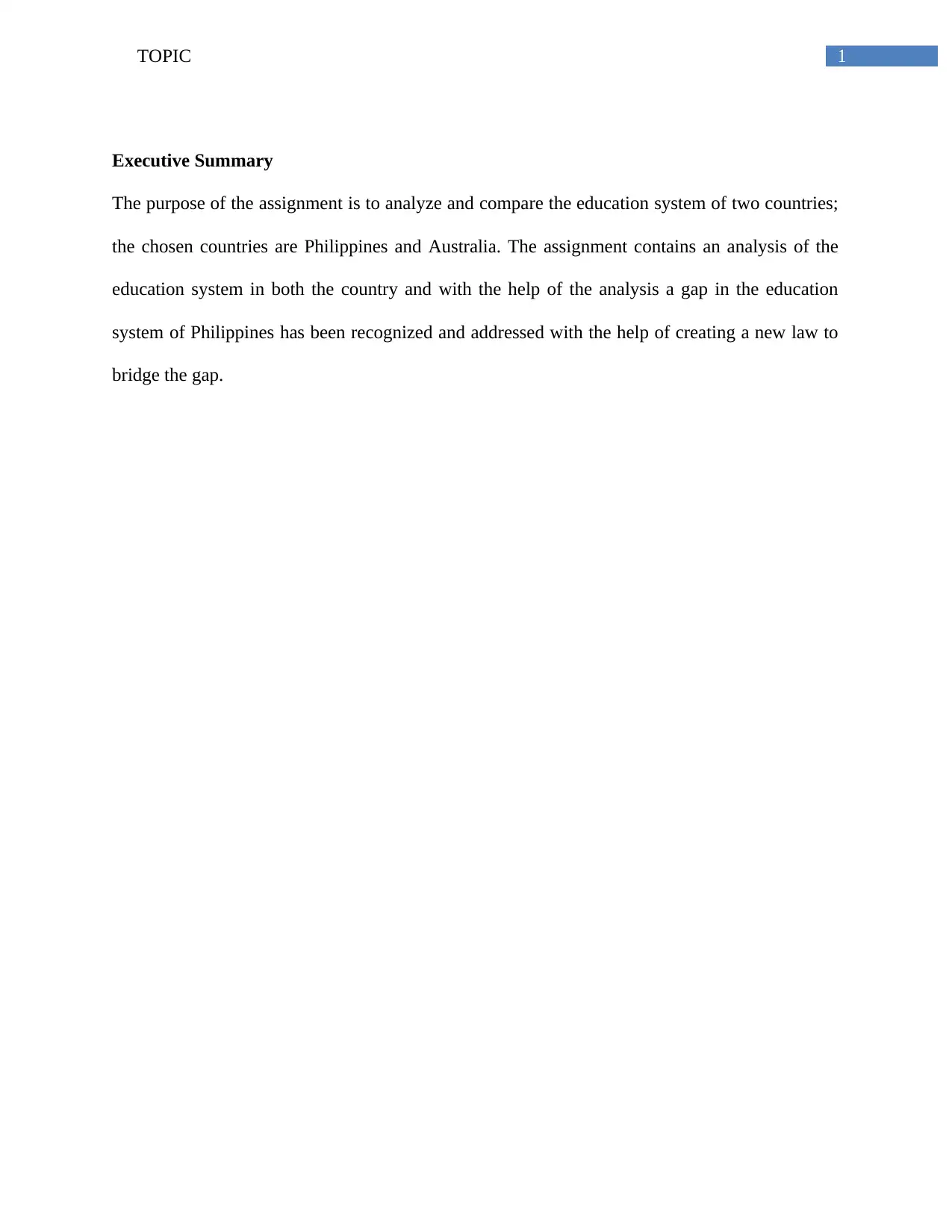
1TOPIC
Executive Summary
The purpose of the assignment is to analyze and compare the education system of two countries;
the chosen countries are Philippines and Australia. The assignment contains an analysis of the
education system in both the country and with the help of the analysis a gap in the education
system of Philippines has been recognized and addressed with the help of creating a new law to
bridge the gap.
Executive Summary
The purpose of the assignment is to analyze and compare the education system of two countries;
the chosen countries are Philippines and Australia. The assignment contains an analysis of the
education system in both the country and with the help of the analysis a gap in the education
system of Philippines has been recognized and addressed with the help of creating a new law to
bridge the gap.
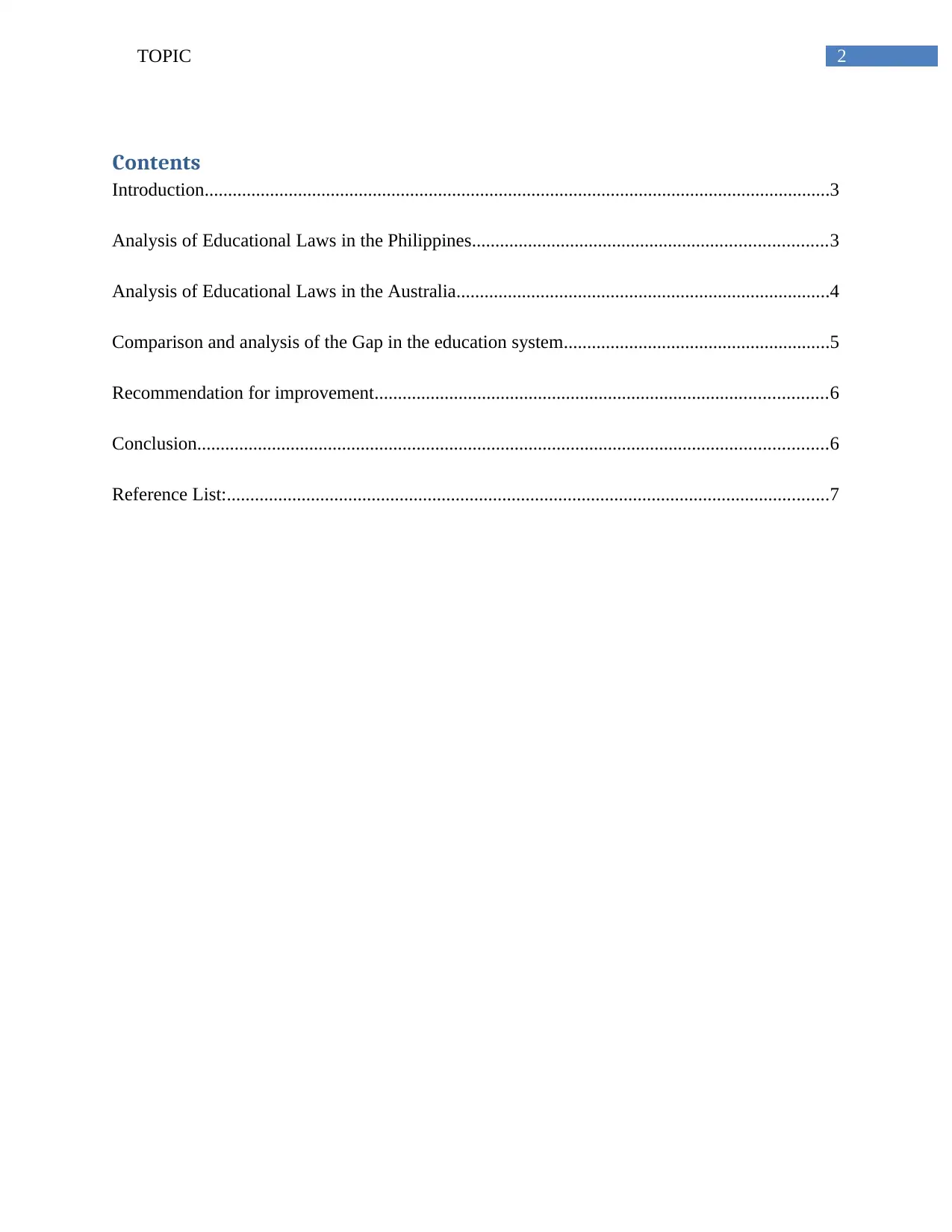
2TOPIC
Contents
Introduction......................................................................................................................................3
Analysis of Educational Laws in the Philippines............................................................................3
Analysis of Educational Laws in the Australia................................................................................4
Comparison and analysis of the Gap in the education system.........................................................5
Recommendation for improvement.................................................................................................6
Conclusion.......................................................................................................................................6
Reference List:.................................................................................................................................7
Contents
Introduction......................................................................................................................................3
Analysis of Educational Laws in the Philippines............................................................................3
Analysis of Educational Laws in the Australia................................................................................4
Comparison and analysis of the Gap in the education system.........................................................5
Recommendation for improvement.................................................................................................6
Conclusion.......................................................................................................................................6
Reference List:.................................................................................................................................7
⊘ This is a preview!⊘
Do you want full access?
Subscribe today to unlock all pages.

Trusted by 1+ million students worldwide
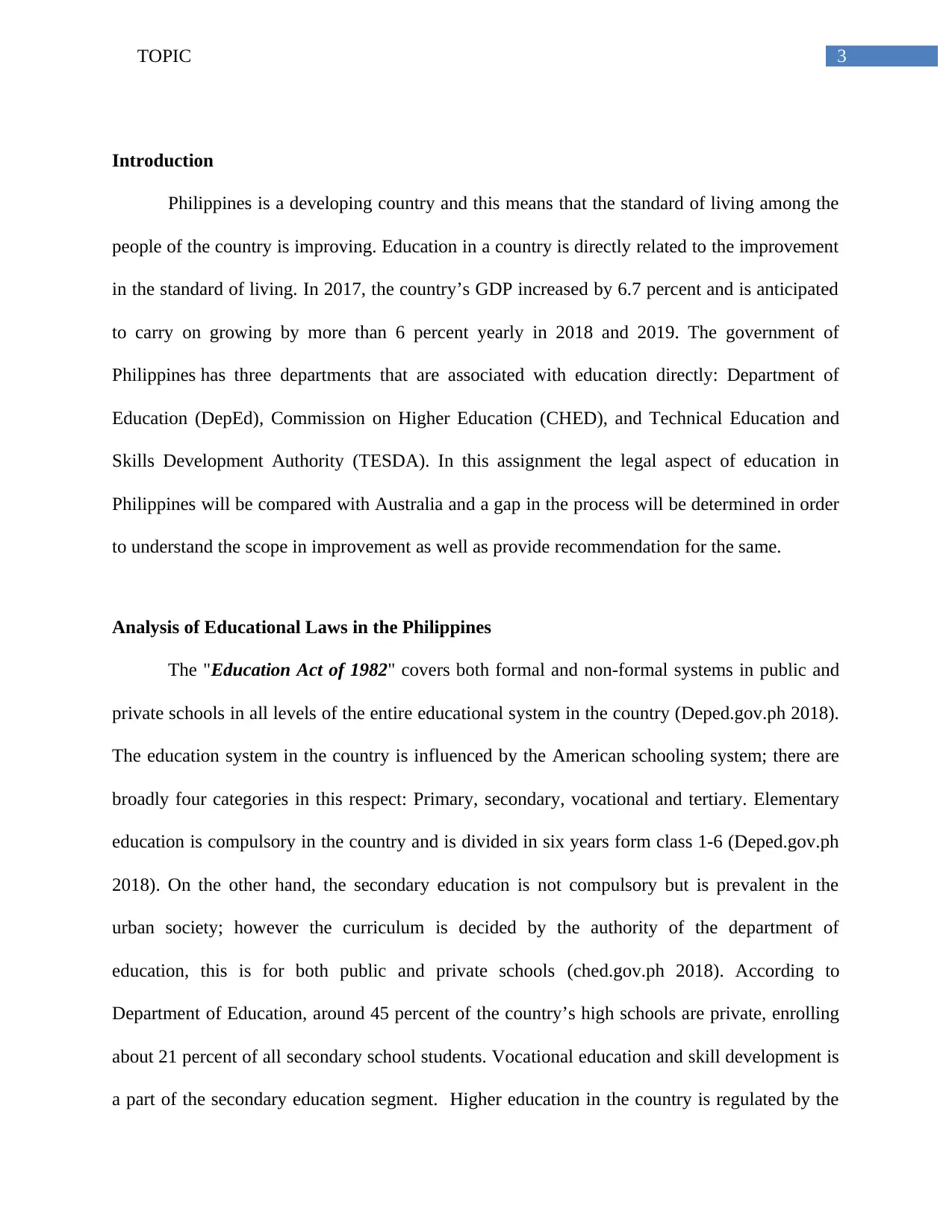
3TOPIC
Introduction
Philippines is a developing country and this means that the standard of living among the
people of the country is improving. Education in a country is directly related to the improvement
in the standard of living. In 2017, the country’s GDP increased by 6.7 percent and is anticipated
to carry on growing by more than 6 percent yearly in 2018 and 2019. The government of
Philippines has three departments that are associated with education directly: Department of
Education (DepEd), Commission on Higher Education (CHED), and Technical Education and
Skills Development Authority (TESDA). In this assignment the legal aspect of education in
Philippines will be compared with Australia and a gap in the process will be determined in order
to understand the scope in improvement as well as provide recommendation for the same.
Analysis of Educational Laws in the Philippines
The "Education Act of 1982" covers both formal and non-formal systems in public and
private schools in all levels of the entire educational system in the country (Deped.gov.ph 2018).
The education system in the country is influenced by the American schooling system; there are
broadly four categories in this respect: Primary, secondary, vocational and tertiary. Elementary
education is compulsory in the country and is divided in six years form class 1-6 (Deped.gov.ph
2018). On the other hand, the secondary education is not compulsory but is prevalent in the
urban society; however the curriculum is decided by the authority of the department of
education, this is for both public and private schools (ched.gov.ph 2018). According to
Department of Education, around 45 percent of the country’s high schools are private, enrolling
about 21 percent of all secondary school students. Vocational education and skill development is
a part of the secondary education segment. Higher education in the country is regulated by the
Introduction
Philippines is a developing country and this means that the standard of living among the
people of the country is improving. Education in a country is directly related to the improvement
in the standard of living. In 2017, the country’s GDP increased by 6.7 percent and is anticipated
to carry on growing by more than 6 percent yearly in 2018 and 2019. The government of
Philippines has three departments that are associated with education directly: Department of
Education (DepEd), Commission on Higher Education (CHED), and Technical Education and
Skills Development Authority (TESDA). In this assignment the legal aspect of education in
Philippines will be compared with Australia and a gap in the process will be determined in order
to understand the scope in improvement as well as provide recommendation for the same.
Analysis of Educational Laws in the Philippines
The "Education Act of 1982" covers both formal and non-formal systems in public and
private schools in all levels of the entire educational system in the country (Deped.gov.ph 2018).
The education system in the country is influenced by the American schooling system; there are
broadly four categories in this respect: Primary, secondary, vocational and tertiary. Elementary
education is compulsory in the country and is divided in six years form class 1-6 (Deped.gov.ph
2018). On the other hand, the secondary education is not compulsory but is prevalent in the
urban society; however the curriculum is decided by the authority of the department of
education, this is for both public and private schools (ched.gov.ph 2018). According to
Department of Education, around 45 percent of the country’s high schools are private, enrolling
about 21 percent of all secondary school students. Vocational education and skill development is
a part of the secondary education segment. Higher education in the country is regulated by the
Paraphrase This Document
Need a fresh take? Get an instant paraphrase of this document with our AI Paraphraser
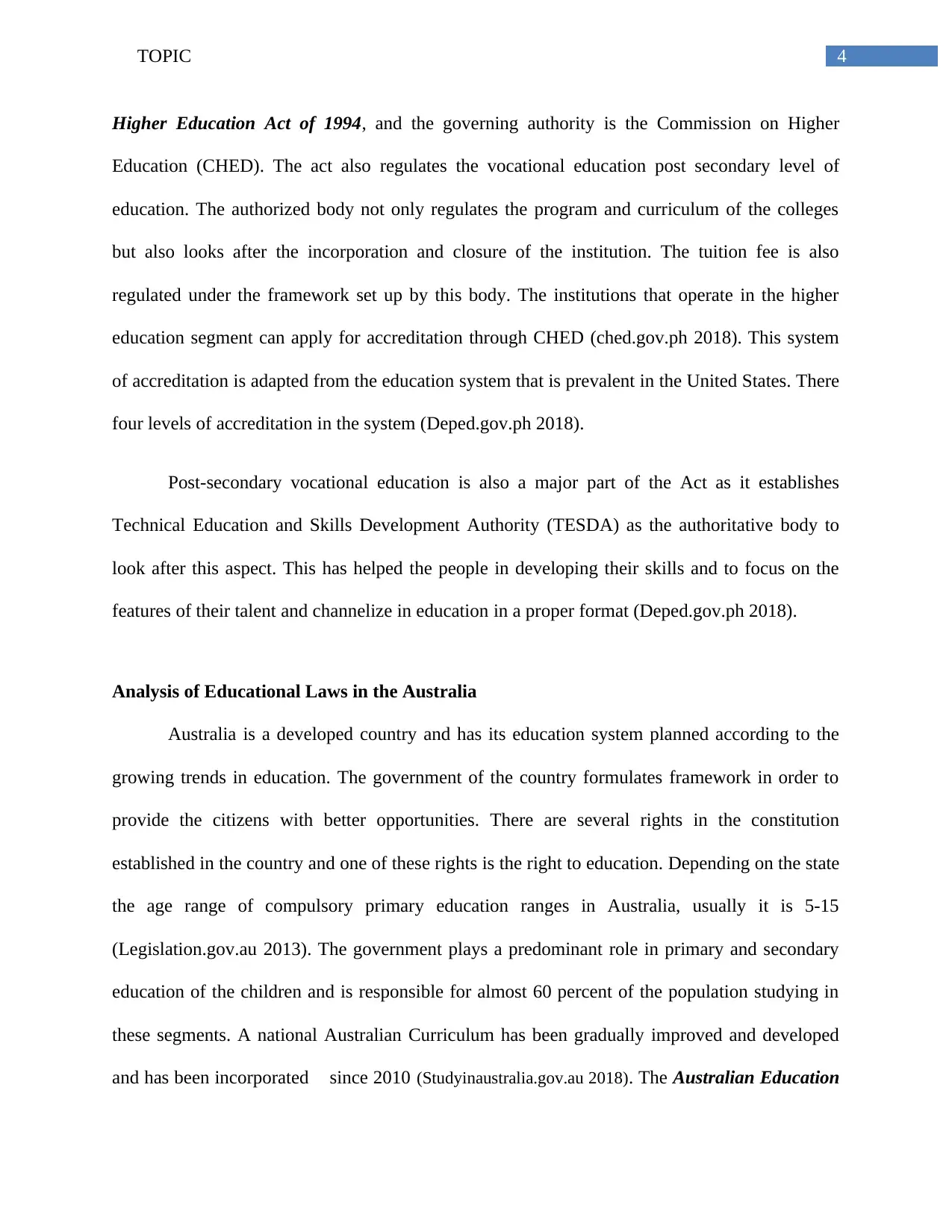
4TOPIC
Higher Education Act of 1994, and the governing authority is the Commission on Higher
Education (CHED). The act also regulates the vocational education post secondary level of
education. The authorized body not only regulates the program and curriculum of the colleges
but also looks after the incorporation and closure of the institution. The tuition fee is also
regulated under the framework set up by this body. The institutions that operate in the higher
education segment can apply for accreditation through CHED (ched.gov.ph 2018). This system
of accreditation is adapted from the education system that is prevalent in the United States. There
four levels of accreditation in the system (Deped.gov.ph 2018).
Post-secondary vocational education is also a major part of the Act as it establishes
Technical Education and Skills Development Authority (TESDA) as the authoritative body to
look after this aspect. This has helped the people in developing their skills and to focus on the
features of their talent and channelize in education in a proper format (Deped.gov.ph 2018).
Analysis of Educational Laws in the Australia
Australia is a developed country and has its education system planned according to the
growing trends in education. The government of the country formulates framework in order to
provide the citizens with better opportunities. There are several rights in the constitution
established in the country and one of these rights is the right to education. Depending on the state
the age range of compulsory primary education ranges in Australia, usually it is 5-15
(Legislation.gov.au 2013). The government plays a predominant role in primary and secondary
education of the children and is responsible for almost 60 percent of the population studying in
these segments. A national Australian Curriculum has been gradually improved and developed
and has been incorporated since 2010 (Studyinaustralia.gov.au 2018). The Australian Education
Higher Education Act of 1994, and the governing authority is the Commission on Higher
Education (CHED). The act also regulates the vocational education post secondary level of
education. The authorized body not only regulates the program and curriculum of the colleges
but also looks after the incorporation and closure of the institution. The tuition fee is also
regulated under the framework set up by this body. The institutions that operate in the higher
education segment can apply for accreditation through CHED (ched.gov.ph 2018). This system
of accreditation is adapted from the education system that is prevalent in the United States. There
four levels of accreditation in the system (Deped.gov.ph 2018).
Post-secondary vocational education is also a major part of the Act as it establishes
Technical Education and Skills Development Authority (TESDA) as the authoritative body to
look after this aspect. This has helped the people in developing their skills and to focus on the
features of their talent and channelize in education in a proper format (Deped.gov.ph 2018).
Analysis of Educational Laws in the Australia
Australia is a developed country and has its education system planned according to the
growing trends in education. The government of the country formulates framework in order to
provide the citizens with better opportunities. There are several rights in the constitution
established in the country and one of these rights is the right to education. Depending on the state
the age range of compulsory primary education ranges in Australia, usually it is 5-15
(Legislation.gov.au 2013). The government plays a predominant role in primary and secondary
education of the children and is responsible for almost 60 percent of the population studying in
these segments. A national Australian Curriculum has been gradually improved and developed
and has been incorporated since 2010 (Studyinaustralia.gov.au 2018). The Australian Education
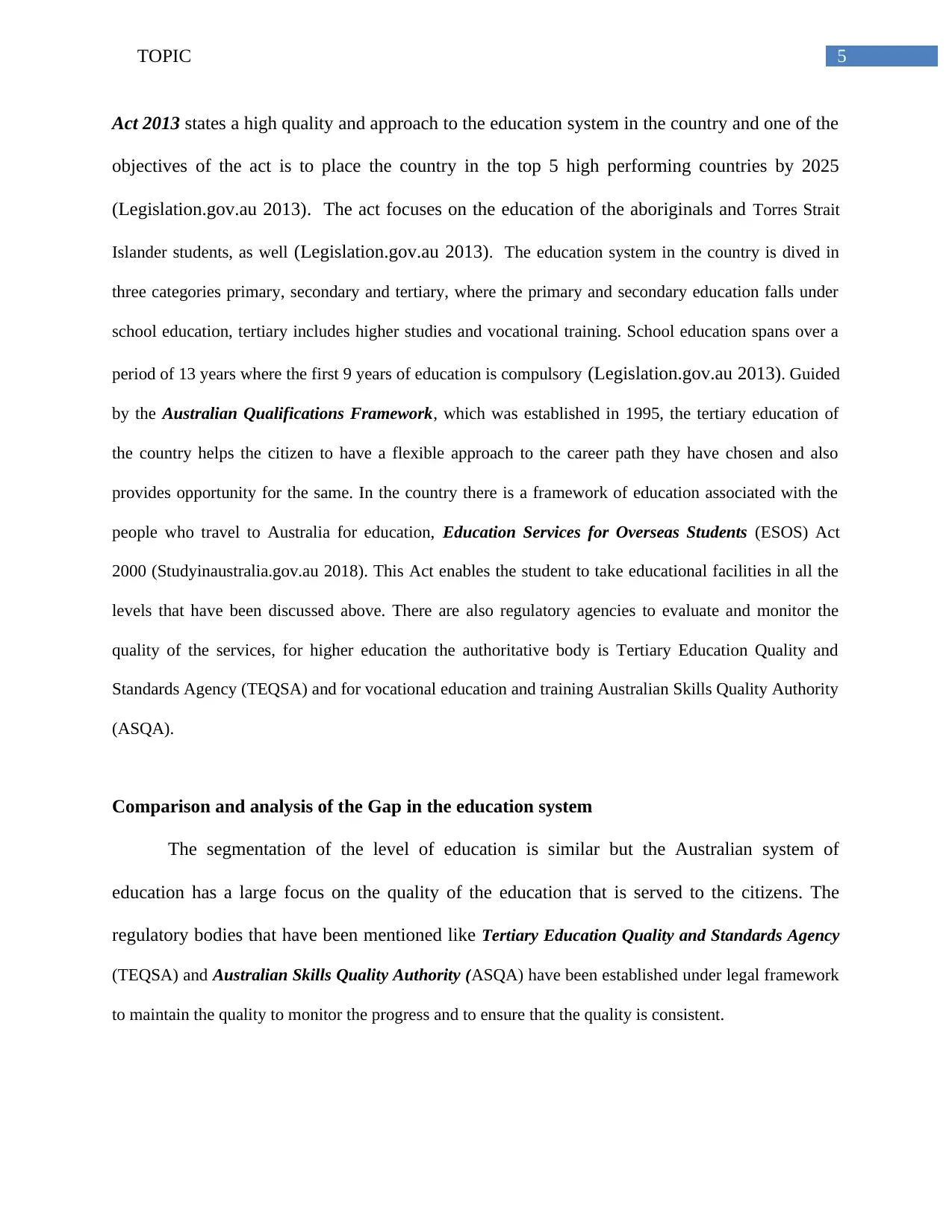
5TOPIC
Act 2013 states a high quality and approach to the education system in the country and one of the
objectives of the act is to place the country in the top 5 high performing countries by 2025
(Legislation.gov.au 2013). The act focuses on the education of the aboriginals and Torres Strait
Islander students, as well (Legislation.gov.au 2013). The education system in the country is dived in
three categories primary, secondary and tertiary, where the primary and secondary education falls under
school education, tertiary includes higher studies and vocational training. School education spans over a
period of 13 years where the first 9 years of education is compulsory (Legislation.gov.au 2013). Guided
by the Australian Qualifications Framework, which was established in 1995, the tertiary education of
the country helps the citizen to have a flexible approach to the career path they have chosen and also
provides opportunity for the same. In the country there is a framework of education associated with the
people who travel to Australia for education, Education Services for Overseas Students (ESOS) Act
2000 (Studyinaustralia.gov.au 2018). This Act enables the student to take educational facilities in all the
levels that have been discussed above. There are also regulatory agencies to evaluate and monitor the
quality of the services, for higher education the authoritative body is Tertiary Education Quality and
Standards Agency (TEQSA) and for vocational education and training Australian Skills Quality Authority
(ASQA).
Comparison and analysis of the Gap in the education system
The segmentation of the level of education is similar but the Australian system of
education has a large focus on the quality of the education that is served to the citizens. The
regulatory bodies that have been mentioned like Tertiary Education Quality and Standards Agency
(TEQSA) and Australian Skills Quality Authority (ASQA) have been established under legal framework
to maintain the quality to monitor the progress and to ensure that the quality is consistent.
Act 2013 states a high quality and approach to the education system in the country and one of the
objectives of the act is to place the country in the top 5 high performing countries by 2025
(Legislation.gov.au 2013). The act focuses on the education of the aboriginals and Torres Strait
Islander students, as well (Legislation.gov.au 2013). The education system in the country is dived in
three categories primary, secondary and tertiary, where the primary and secondary education falls under
school education, tertiary includes higher studies and vocational training. School education spans over a
period of 13 years where the first 9 years of education is compulsory (Legislation.gov.au 2013). Guided
by the Australian Qualifications Framework, which was established in 1995, the tertiary education of
the country helps the citizen to have a flexible approach to the career path they have chosen and also
provides opportunity for the same. In the country there is a framework of education associated with the
people who travel to Australia for education, Education Services for Overseas Students (ESOS) Act
2000 (Studyinaustralia.gov.au 2018). This Act enables the student to take educational facilities in all the
levels that have been discussed above. There are also regulatory agencies to evaluate and monitor the
quality of the services, for higher education the authoritative body is Tertiary Education Quality and
Standards Agency (TEQSA) and for vocational education and training Australian Skills Quality Authority
(ASQA).
Comparison and analysis of the Gap in the education system
The segmentation of the level of education is similar but the Australian system of
education has a large focus on the quality of the education that is served to the citizens. The
regulatory bodies that have been mentioned like Tertiary Education Quality and Standards Agency
(TEQSA) and Australian Skills Quality Authority (ASQA) have been established under legal framework
to maintain the quality to monitor the progress and to ensure that the quality is consistent.
⊘ This is a preview!⊘
Do you want full access?
Subscribe today to unlock all pages.

Trusted by 1+ million students worldwide
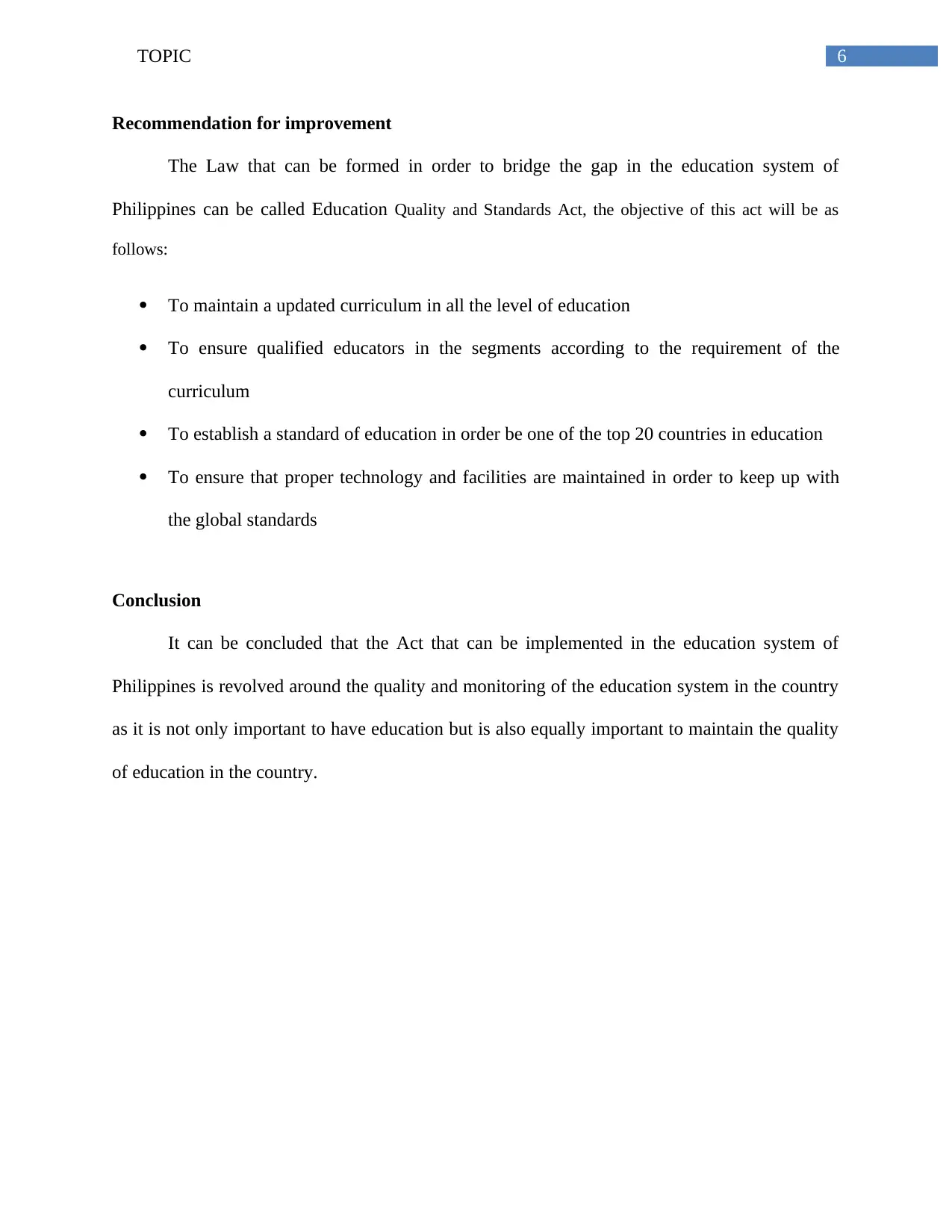
6TOPIC
Recommendation for improvement
The Law that can be formed in order to bridge the gap in the education system of
Philippines can be called Education Quality and Standards Act, the objective of this act will be as
follows:
To maintain a updated curriculum in all the level of education
To ensure qualified educators in the segments according to the requirement of the
curriculum
To establish a standard of education in order be one of the top 20 countries in education
To ensure that proper technology and facilities are maintained in order to keep up with
the global standards
Conclusion
It can be concluded that the Act that can be implemented in the education system of
Philippines is revolved around the quality and monitoring of the education system in the country
as it is not only important to have education but is also equally important to maintain the quality
of education in the country.
Recommendation for improvement
The Law that can be formed in order to bridge the gap in the education system of
Philippines can be called Education Quality and Standards Act, the objective of this act will be as
follows:
To maintain a updated curriculum in all the level of education
To ensure qualified educators in the segments according to the requirement of the
curriculum
To establish a standard of education in order be one of the top 20 countries in education
To ensure that proper technology and facilities are maintained in order to keep up with
the global standards
Conclusion
It can be concluded that the Act that can be implemented in the education system of
Philippines is revolved around the quality and monitoring of the education system in the country
as it is not only important to have education but is also equally important to maintain the quality
of education in the country.
Paraphrase This Document
Need a fresh take? Get an instant paraphrase of this document with our AI Paraphraser
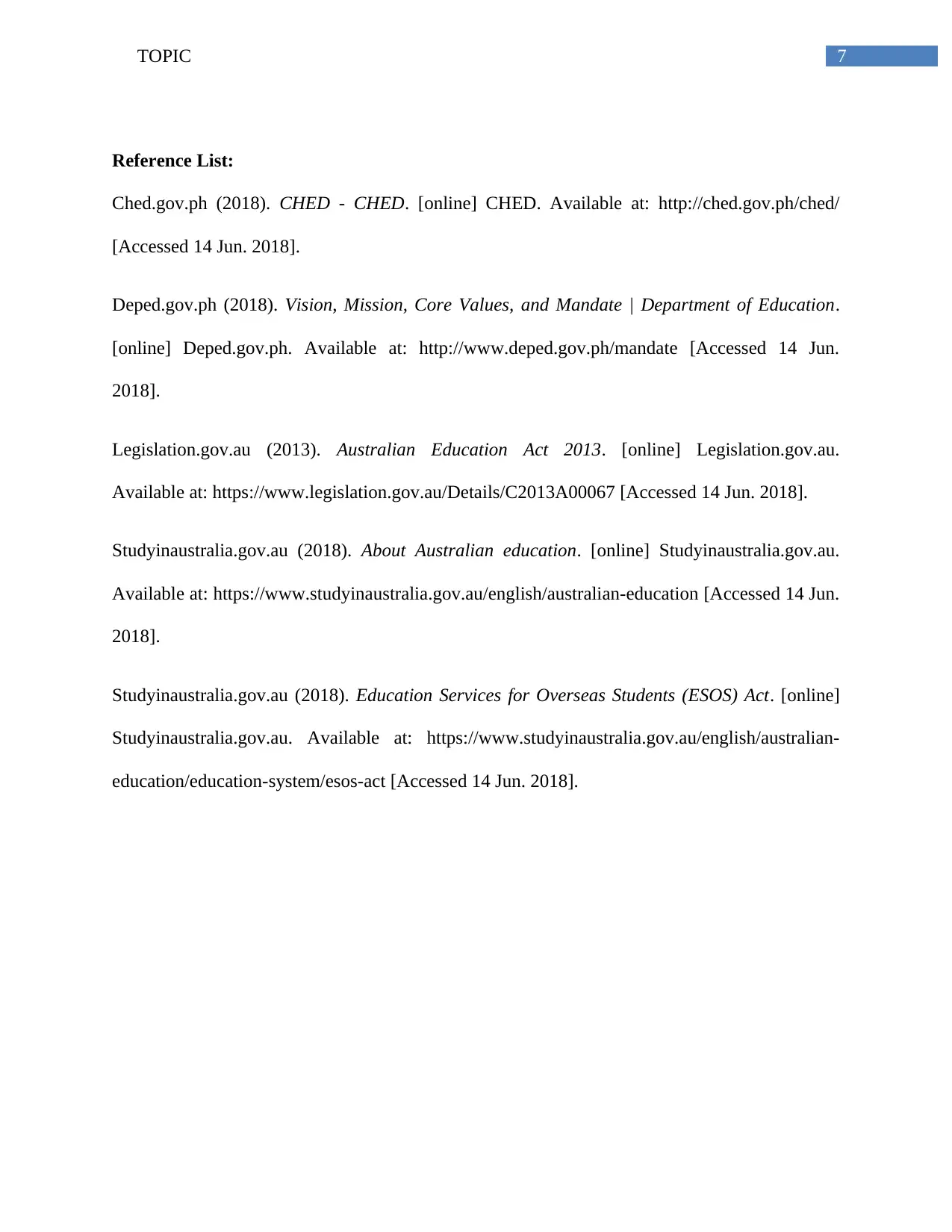
7TOPIC
Reference List:
Ched.gov.ph (2018). CHED - CHED. [online] CHED. Available at: http://ched.gov.ph/ched/
[Accessed 14 Jun. 2018].
Deped.gov.ph (2018). Vision, Mission, Core Values, and Mandate | Department of Education.
[online] Deped.gov.ph. Available at: http://www.deped.gov.ph/mandate [Accessed 14 Jun.
2018].
Legislation.gov.au (2013). Australian Education Act 2013. [online] Legislation.gov.au.
Available at: https://www.legislation.gov.au/Details/C2013A00067 [Accessed 14 Jun. 2018].
Studyinaustralia.gov.au (2018). About Australian education. [online] Studyinaustralia.gov.au.
Available at: https://www.studyinaustralia.gov.au/english/australian-education [Accessed 14 Jun.
2018].
Studyinaustralia.gov.au (2018). Education Services for Overseas Students (ESOS) Act. [online]
Studyinaustralia.gov.au. Available at: https://www.studyinaustralia.gov.au/english/australian-
education/education-system/esos-act [Accessed 14 Jun. 2018].
Reference List:
Ched.gov.ph (2018). CHED - CHED. [online] CHED. Available at: http://ched.gov.ph/ched/
[Accessed 14 Jun. 2018].
Deped.gov.ph (2018). Vision, Mission, Core Values, and Mandate | Department of Education.
[online] Deped.gov.ph. Available at: http://www.deped.gov.ph/mandate [Accessed 14 Jun.
2018].
Legislation.gov.au (2013). Australian Education Act 2013. [online] Legislation.gov.au.
Available at: https://www.legislation.gov.au/Details/C2013A00067 [Accessed 14 Jun. 2018].
Studyinaustralia.gov.au (2018). About Australian education. [online] Studyinaustralia.gov.au.
Available at: https://www.studyinaustralia.gov.au/english/australian-education [Accessed 14 Jun.
2018].
Studyinaustralia.gov.au (2018). Education Services for Overseas Students (ESOS) Act. [online]
Studyinaustralia.gov.au. Available at: https://www.studyinaustralia.gov.au/english/australian-
education/education-system/esos-act [Accessed 14 Jun. 2018].
1 out of 8
Related Documents
Your All-in-One AI-Powered Toolkit for Academic Success.
+13062052269
info@desklib.com
Available 24*7 on WhatsApp / Email
![[object Object]](/_next/static/media/star-bottom.7253800d.svg)
Unlock your academic potential
Copyright © 2020–2025 A2Z Services. All Rights Reserved. Developed and managed by ZUCOL.




